Final report for FNE17-864
Project Information
My grant research looked into the use of spent brewers’ grain from a local brewery as a field amendment for crop growth. In particular, I looked at bokashi composting as a means to stablize the spent grains, which have a tendency to go anaerobic because of its high nitrogen and moisture content.
I set up two experimental groups to compare alongside a control: one using fresh spent brewers’ grain, the other using bokashi’d spent brewers’ grain prepped on the farm. The experiment used head lettuce and huskcherries as trial crops. Spent grain was added to the soil, incorporated, then transplanted into with plants.
Substantial increased initial growth was noted in the field – about double that of the control groups. Photos are included in the report. Yields, largely speaking, increased as well. The huskcherry experimental groups showed a 26-29% (bSBG and SBG, respectively) increase in yield over the control, while five out of six varieties of the head lettuce showed increases ranging from 49-164% (bSBG and SBG, respectively). The one variety of head lettuce that showed a yield decrease, showed a decrease of 15%. This is noted in the report, but a design flaw in the experiment made measuring yields in the head lettuce challenging. While I do believe the spent grains increased crop yield, I would run the experiment again for more solid quantitative data to support this finding.
Improved frost protection was one unanticipated result observed in my research. The spent grain huskcherry plantings, which have a later season harvest window, were able to survive a severe October cold spell under row cover. While the control petered out (despite being under the same piece of row cover), I was able to harvest from the experimental groups for another month. A compost analysis of the spent grains suggests that high silica levels in the spent grains may have played a role in this.
While I had to limit the initial scope of the experiment to better reflect what was feasible in the throes of the farm season, and there are certainly ways I will approach future research differently, overall the project went well. Bokashi’ing and holding much of the spent grains before the farm season began in earnest allowed for an easy way to have the amendment on hand when it was needed. 55-gallon containers proved to be a good method of working with the spent grain having a tractor.
Outreach occured via blog posts, on the MOFGA journeyperson listserv, as a part of a presentation to a group of 15 Bates students at the Vassalboro Grange, and on the main online farming group I participate (Market Garden Success Group) in on Facebook. It’s hard to estimate the number of people reached via the blog or listserv, but the posts I made to the FB group reached 153 people.
Introduction:
Research for this grant project was prompted by an interest in figuring out a way that spent brewers' grain could be handled in a safe and affordable way for small-scale vegetable farmers. I had some sense already that SBGs could effectively be used as a soil amendment. The challenge is that their 'shelf life' after leaving the masher at a brewery, especially in warm summer weather, is limited. As a pasteurized substrate with a high-nitrogen and moisture content, spent brewers' grain can quickly go anaerobic. Some vegetable farmers and compost producers address this by actively aerating SBGs with a windrow turner, which is effective but also labor/tractor intensive and requires a significant investment in farm equipment.
Bokashi composting is seen as a way to address this for farms. By intentionally inoculating SBGs with beneficial anaerobes, farmers can exclude colonization by anaerobes known to raise food safety concerns, and stabilize the product for several months vs. days. A tractor is helpful for transport of grains to the field, but air-tight, food-grade containers and an initial purchase of bokashi inoculant is all that's needed to get going. While I opted for 55-gallon screw-top drums, one could use 5-gallon buckets depending on scale/desired application rate. Low cost of entry makes forming collaborations with local breweries far more feasible for small-scale producers.
For mine and other farms, bokashi composting makes a source of organic matter rich in nutrients available for vegetable production. Further research is needed to clarify its constituent parts and effects on soils and plants, but bSBGs is one more tool in the farmer's toolkit for fertility management. As a free resource, locally-available, spent brewers' grain will help cut the cost of my crop production, and managed properly, I believe, benefit my soils in the long-term.
This grant study seeks to investigate whether bokashi is an effective composting method for incorporating bokashi’d spent brewers’ grains [SBGs] into a farm’s fertility program.
What is the effect of bSBGs on field fertility and soil microbiology?
How does the use of bSBGs affect plant growth/yield? What is the labor breakdown needed to produce/apply bSBGs?
My objective was to compare the effect applications of bSBGs have on soil and field plantings. Crops were trialed, and compared against a control and an application of fresh spent brewers' grains. I looked at changes in nutrient availability, soil pH, cation exchange capacity, % organic matter, and yield of two crops: Salanova lettuce and huskcherries. Qualitative differences in appearance, as well as pest, weed, and disease pressure were also noted.
This past year was my eighth year farming, but my second year having returned to the Northeast to start Full Fork Farm. 2016 was Full Fork's first year in production. The farm's main focus is the salad plate, producing baby salad greens, edible flowers, microgreens, cherry tomatoes on a 1/2-acre. I provide produce to restaurants in the Waterville area, a grocery store, one caterer, two distributors, and an aggregated-CSA. There are a few other crops - parsley, for instance, and garlic - that fall outside the farm's focus but are grown for specific buyers. On-site sales occurred this year, too, but were small and are not expected to grow until next year with the opening of an additional 1/2-acre u-pick strawberry patch. In this first year, the farm has typically grossed $700-1,000/week. I do also have 5-additional acres of pasture in cover crop and straw/hay mulch, but this acreage requires negligible work because a neighboring dairy farmer leases 19-acres from me in trade for tractor work.
In addition to Full Fork Farm, I work part-time 20-25 hours a week at Oxbow Brewery in Newcastle, where I will be sourcing the spent brewers’ grains. I manage the tasting room's grounds, orchard, and animals. Work at Oxbow offers me a flexible schedule that I can shift depending on the needs of the farm each week.
As the number of craft breweries in the U.S. expands, what might otherwise become a potential agricultural pollution has the potential of being turned into an affordable opportunity for local farmers to build soil fertility and health. The brewery I will partner with - Oxbow Brewing in Newcastle, ME - currently produces 1,500 to 2,000 lbs. of spent brewers’ grains per week. From personal experience, I can say that the spent brewers’ grains [SBGs] will begin showing signs of anaerobic decomposition within several days post-brew. The SBGs high moisture content favors anaerobic decomposition. There are mechanical systems that have been developed that can actively aerate compost piles to prevent this, but the high cost for the equipment is a major hurdle for small farms. What’s needed is an effective process that is simple, affordable, and manageable within a farm's overall operation.
As a safe form of anaerobic decomposition, and with a one-month completion time from raw material to full incorporation into the soil, bokashi may be the technique needed to overcome these challenges with spent brewers’ grains. Bokashi is a composting technique developed in Japan that primarily works with lactobacillus to pickle biomass, similar to the production of silage. Organic matter is pickled in an airtight container for two weeks, then it’s buried in the field soil. Rapid aerobic decomposition of the biomass/anaerobes follows, leading to full incorporation into the soil in about two weeks time.
For a vegetable farmer, this two-week timeline will provide a fresh, source of fresh nutrients/OM throughout the main growing season. Traditional hot pile composting takes 3 months and ongoing management to reach a finished product. What will be called bokashi-SBGs [bSBGs] needs only a month, and two of those weeks are spent in the field rows where the amendment can be utilized. A farmer can apply and till in the bSBGs alongside their other amendments following a crop termination and expect full incorporation in time for the following planting.
The bSBGs will not require as much labor needed to produce thermophilic compost. Many vegetable farmers elect to purchase-in compost due to the time and attention needed to safely produce a high-quality finished product. With bSBGs, field application is part of the composting process. Incorporating them into a farm’s fertility plan would reduce the labor/cost needed to increase soil OM and maintain soil microbial health.
Finally, if kept in airtight containers, the bSBGs remain in a stable, relatively dormant state following fermentation. Farmers have flexibility regarding when to apply bSBGs in the field, allowing them to fit it into their schedules. Farmers can stockpile bSBGs through the winter for use at the start of the growing season.
Cooperators
- - Technical Advisor (Educator)
Research
The scope of this SARE grant was to investigate the use of bokashi composting as a stabilization technique for using spent brewers' grain [SBGs] in the field as a soil amendment, and to measure the SBGs effect on crop yield and soil nutrient levels.
I began picking up spent brewers' grain from Oxbow Brewery throughout the month of April to incorporate bokashi composting inoculant. I used 55-gallon, screw-top food grade barrels for transport.
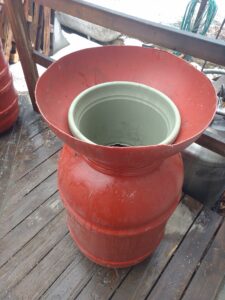
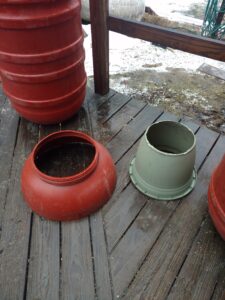
A simple funnel was fashioned out of the top of one of the barrels with a round planting container used to hold it in place to transfer the spent grains from the masher. This little DIY funnel made the difference as far as having the grant's need for SBGs unobtrusive for the brewers daily work flow.
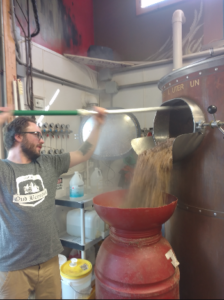
Inoculation of the spent brewers' grain was done back at the farm into empty 55-gallon containers in alternating layers of SBGs (3"-4") and a light dusting inoculum (about a handful of inoculum per layer, looking for even spreading across the surface), then compressed into the barrels to exclude oxygen using the bottom of a 5-gallon bucket until the barrels were full. [This compression step was included because bokashi thrives in anaerobic conditions, but may not have been absolutely necessary.] The bokashi inoculant was purchased as a 5-gallon container of EM-1® Bokashi from Arbico Organics for about $80 plus shipping, which was more than enough for the research project. It does work to use previously inoculated spent brewers' grain as inoculant for other bins in a similar fashion mentioned above; this was not done for the project to eliminate it as a variable in the experiment. Also, the inoculation process ideally would have been done at the brewery itself during the SBG transfer process, but was avoided so as not to slow down the brewers' workflow and present microbes into the brewery environment.
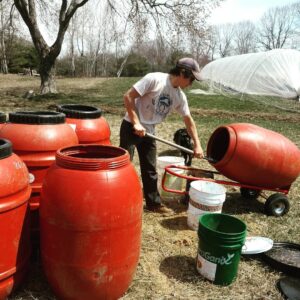
Barrels were then allowed to compost anaerobically to become bokashi-SBGs [bSBGs]. At least two weeks is the traditional time required for bokashi composting.
Fresh SBGs for the experiment were picked up two weeks later on May 26th. All spent brewers' grain - both fresh SBGs and bSBGs - were applied on June 6th. I used a tractor to transport the barrels, hand shoveled the spent brewers' grain, then incorporated the grains using a BCS 853 and power harrow. This step was made challenging - though not impossible - due to the wet nature of the SBG and bSBGs. Two 125' rows of each crop, each split into three 41.5' sections were created, testing applications of SBGs, bSBGs, and a control
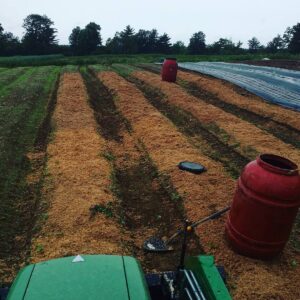
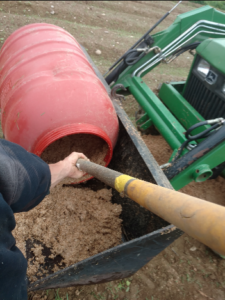
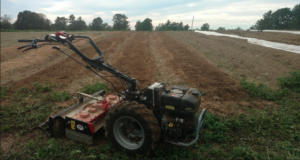
Following this, landscape fabric with planting holes was applied for weed control. The landscape fabric worked generally well, but still required weeding during the season.
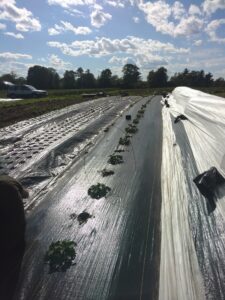
I initially planned to test several crops, but reduced the number to two: huskcherries and Salanova lettuce. This decision was made based upon the amount of spent grains that could be acquired. I also did not use the irrometer to investigate the SBG's effect on water-holding capacity during the season.
Huskcherries were started on March 1st, then transplanted on June 14th. Accelerated growth was noted in the SBG/bSBG huskcherry groups on July 8th. The plants were significantly larger than the control group. Representative photos were taken [below].

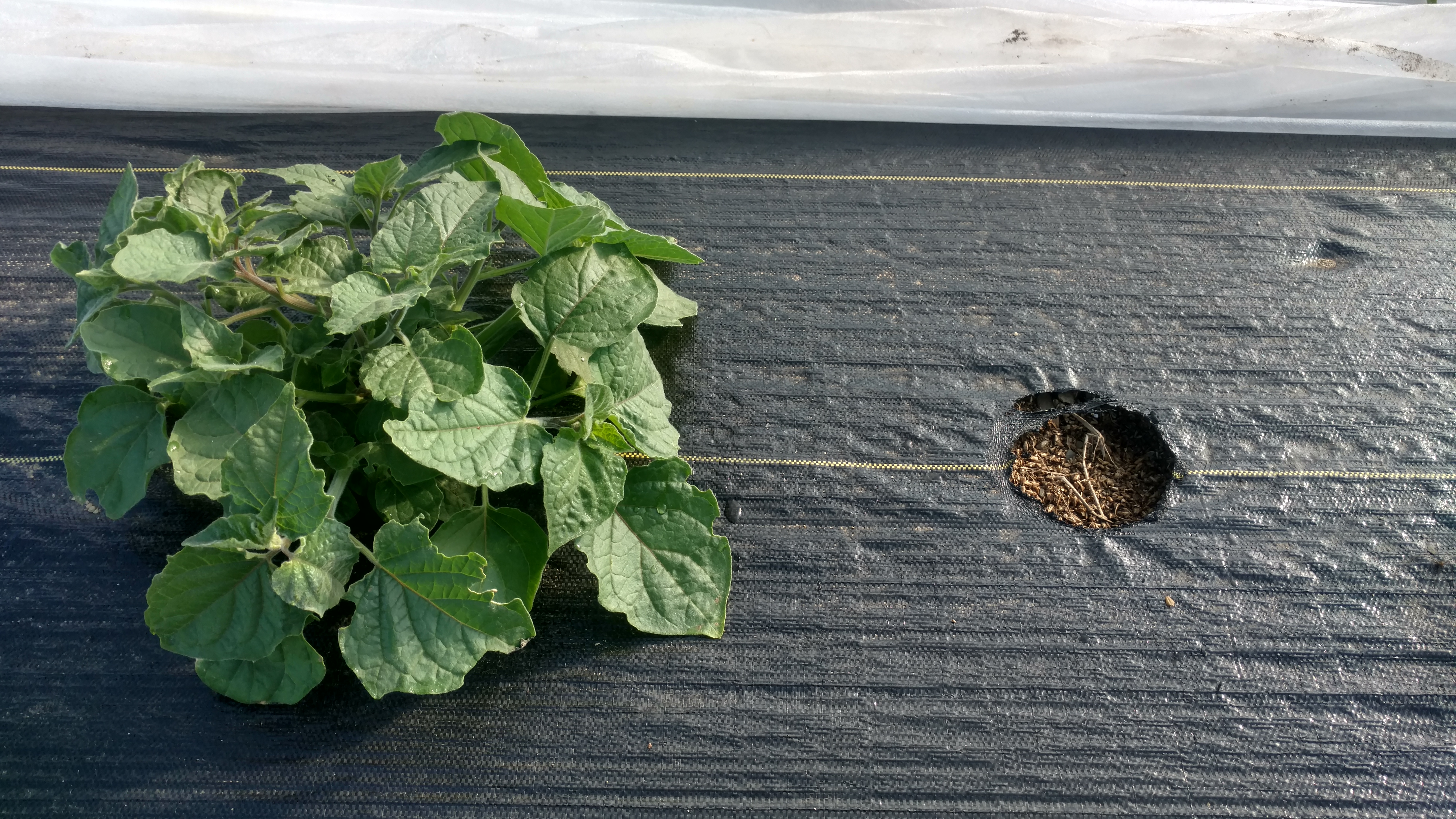
The Salanova was started June 7th, and transplanted July 3rd. Row cover was applied to the huskcherries to provide a warmer microclimate, but also to exclude three-lined beetles. This measure was helpful but ultimately failed, and two rounds of Pyganic were applied on 7/2 & 7/10.
Data collection for the grant consisted of soil testing, and weighing crop yields. Harvest of Salanova occurred for three weeks in August on 8/16, 8/21, & 8/30 until it began to bolt, coming up with an average head weight for the various varieties. Harvest of huskcherries began in October and occurred on 10/6, 10/7, 10/21, and 11/5-11/7, measuring an overall yield weight of each group.
Crop Yields
Huskcherry yields increased by 26% and 29% for both the bSBG and SBGs experimental groups versus the control, respectively. It's unclear, however, if this increased yield was a result of greater fruit set. An unexpected result of the experiment is that the SBG/bSBG plots far outlived the control when fall frosts began in earnest in October. This, despite all three being under the same piece of row cover. The greater frost protection allowed the experimental plots additional time to ripen harvestable fruit.

This chart shows huskcherry crop yield and % yield difference compared to the control:

The ability to measure Salanova yields was challenged by an experimental design flaw. All eight varieties of Salanova were transplanted into the field but randomly so, without an equal number of each in all three design groups. It was an oversight, the result of which is that I was only able to measure comparative yields of five of the varieties by average weight [see chart below]. Yield increases were observed in all but one of these varieties.

Soil Testing
An an initial baseline soil test was sent to Logan Labs on 6/1. Being my first time using the lab, I was surprised when the results did not include an analysis for nitrogen. This had me make a decision to shift labs to the University of Maine's testing services in Bangor. I sent tests off on 7/8 after incorporating the spent grain into the field. I collected samples from the SBG plots, the bSBG plots, and the control plots. [Unfortunately, the fall analysis from U. of Maine also did not include a measure for N, so I am unable to offer results even after the shift of soil testing facilities.]
The spring soil tests give some indication of the qualities of spent brewers' grains. The tests showed an increase in phosphorus, magnesium, nitrogen, manganese, and zinc, as well as a .5-1.5% increase in soil organic matter, and a 2-4% increase in cation exchange capacity. These tests also show a decrease in potassium versus the control, and mixed results for calcium and sulfur levels.
Post-harvest soil tests suggest the following about using spent brewers' grains as a soil amendment:
- End of the season testing show strong indications of increase of phosphorus, manganese, zinc, and OM in the soil. Magnesium trended towards increased levels in the soil.
- Some tests - for potassium, iron, sulfur, and CEC - showed mixed results of both increases and decreases that would benefit from further inquiry.
- Soil pH showed increases, but I believe this is likely a result from lime applied in 2016. This is supported by the fact that the pH control groups also increased during the season.
- Finally, and curiously, where calcium levels showed a decrease in the experimental SBG plots, the levels in the bSBG plots showed increases [+9#/ac. and +60#/ac.].
Compost Analysis
To better understand the spent grains effect's on the soil during the growing season, new samples of SBGs and bSBGs from a single mash from Oxbow Brewery were sent to the U. of Maine Testing Services. (View test results here: 180354.) While these were not samples taken of the actual amendment spread in the field for the research, the idea was to get a general sense of spent grains' nutrient profile. Two things stand out in the results.
The first is that silica levels for the SBG and bSBGs at 15042 mg/kg and 11680 mg/kg, respectively, suggest that the Si content in the amendment application may have been playihng a role in the late-season frost protection of the huskcherry crop.
The second notable result is the differing nitrogen measures between the two spent grain samples. While the lbs/ton. of nitrogen was relatively similar between them at 17.88 (SBGs) and 17.05 (b.SBGs), the molecule the nitrogen was found as was not. The nitrate level (NO3-) in the SBGs measured far greater than that of the bSBGs, which hardly contained any nitrates. Ammonium (NH4) levels between the two were similar. Something clearly occurs in the bokashi composting process to convert the nitrates to a different molecule containing N than was tested for by U. of Maine's standard compost analysis.
A cursory look at published academic research suggests a couple a potential avenue for further inquiry. Some studies observed some species of lactobacilus - L. plantarum and L. fermentum - converting nitrates to nitrites (NO2-). While in my trials a 1/2" of bSBG to the experimental plot produced no noticeable difference in growth in comparison to the SBG plot, standard farm advice is to be wary of adding nitrites to one's soil since an abundance can be toxic to plant growth. A multi-year study using bSBGs on the same land would be useful.
One hypothesis, provided I'm on the right track about L. spp. being the primary actors converting NO3- to NO2-, is that Nitrobacter spp. in the soil are then converting the nitrites to nitrates following amendment incorporation, thereby making the nitrogen in a plant-available form again.
What I find interesting about this idea is that Nitrobacter spp. pull CO2 out of the atmosphere to complete the nitrate to nitrate conversion. Does this mean that bSBGs are able to sequester just a little extra carbon compared to SBGs? Or does the bokashi composting process, or its subsequent incorporation into the soil - produce CO2 that balances the Nitrobacter spp. role in carbon cycling? It's said that bokashi composting produces very little CO2 offgassing, but I do not know if that assertion is backed by research looking solely at the pickling step, or if it also tested CO2 production when the actual bokashi'd organic matter is incorporated into the soil and truly begins to decompose. All interesting avenues to consider.
Other Notes
A final important thing to note is that the 2017 growing season was a slow one for many fruiting vegetables and plants. This was experienced on our farm, and related anecdotally by other farmers in the area. Whether or not, or how, this might have affected the huskcherries' growth and yield, I cannot say, but is worth mentioning.
The purpose of this research project was to look at bokashi composting as a technique for stabilizing spent brewers' grain for safe use in crop production, and to look at the effect of spent brewers' grain on soil fertility and yield. Fresh spent brewers' grain and bokashi'd spent brewers' grain were applied in the spring, then planted with huskcherries and Salanova lettuce. Soil tests and yields were measured in the course of the growing season.
Despite some challenges that arose and required changes in the study, this past season demonstrated to me that bokashi composting is an effective way to hold spent brewers' grain for use as a soil amendment. It's also raised further questions. What is an appropriate application rate? What is it in the SBGs that offered to the huskcherries extra frost protection last season? Does the bokashi composting process effect calcium in a positive way? How might one best incorporate SBGs into a fertility program for long-term soil nutrient balancing with the net increases shown from its application?
Spent brewers' grains offers a free, local amendment for crop growth, and bokashi composting offers a technique to work with it safely. I intend to continue to work with it, and hope to convince other farmers to do the same. I'm now interested in sending samples of both SBGs and bSBGS to a lab for analysis to learn a more precise understanding of its nutrient offerings. Knowing this, I believe, is the best step forward to learn how to apply it effectively to address the needs of crops and soils.
Education & outreach activities and participation summary
Participation summary:
To this point, I have written two blog posts and connected with other farmers through the main farming-related group I participate in, 'Market Garden Success Group'. The post I made at the season's start generated discussion and reached 153 farmers. My intention is to write one more blog post with the grant project's results and offer up my findings to the group.
The research grant was featured as a cover story in the local paper (article link). I also presented to a group of 15 Bates students about the farm and project last spring at the Vassalboro Grange.
Both Oxbow Brewery and Gowan Batist, my advisor, spoke about getting word out about the project when it was first beginning. It remains to be seen in what form this may take, but my intention is to follow up with them at the full conclusion of the project.
Learning Outcomes
It's hard to estimate the 'awareness' component of KASA. I do know, though, that the FB posts I made to 'Market Garden Success Group' reached 153 farmers, and generated some discussion.
Separating awareness from the equation, there is a smaller handful of farmers impacted by my research. I had a long phone conversation with one farmer on Maine's coast as she and her partner consider incorporating spent grains into their farm's operation. A couple other farmers I've spoken with have shown interest in the spent grain's yield increase and added frost protection. Whether this will lead them to work with bokashi composting of spent grains, specifically, I'm unsure, but the awareness of it as an option is there.
For myself, conducting this research through SARE has helped me to hone my own method for working with spent grain on the farm. It is definitely an organic material I intend to continue to work with. The research has raised questions for me asking further inquiry. What is the ideal application rate for measurable effect on yield? What is too much? And for added frost hardiness? What is the long-term effect on soil/plant health, pH, and soil microbiology?
Project Outcomes
While further research is needed to determine an ideal application rate and long-term effects on soil/plant health, I still intend to continue working with spent grains as a part of the farm's soil fertility management program. Taking on spent grains from the local brewery seems to be an excellent way to decrease purchased-in nitrogen fertilizer costs, as well as a micro-nutrient of silica, while increasing yields. Furthermore, for my sandy soil, the spent grains grants the added benefit of increasing organic matter in the soil.
A primary challenge to using spent brewers' grain is a good working relationship for both the brewers and the farmer. The 55-gallon containers used for the research project worked well enough in the brewery, but were somewhat unwieldy when full - each weighing a couple hundred pounds. Where the brewers are operating on a schedule and it's far easier for them to use a pallet jack to manipulate a larger IBC tote, some other fix would be needed to make things work long-term.
As for the experiment itself, if I were to conduct it a second time, I would limit the head lettuce trial to a single variety for ease of yield measurement. Being my first on-farm research project, this was an oversight on my part. I was wanting to incorporate the experiment into my farm's market production plan, but it would have been better in this case to keep it separate and simple.
An area I believe more research is needed is to understand the interplay between nitrate and nitrite that may be occurring using bokashi composting as a method to stabilize the spent brewers' grain. If this is a conversion process happening, it's important to understand what's happening with the soil on both the short- and long-term when bSBGs are incorporated into the soil.